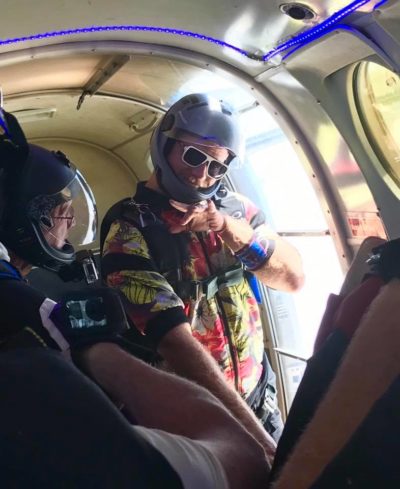If you search skydiving on the internet, you will find all sorts of fun formations, positions, and tricks that licensed skydivers do. Once you become an experienced skydiver, there are several different disciplines and orientations that you have the opportunity to learn, but the first body position that every single skydiver must master before any other is “the arch.” Haven’t heard of it? No worries, you’ll be introduced to the skydiving arch when you make your tandem skydive.
What is the Skydiving Arch?
 The arch is an absolutely essential body position in skydiving. Also known as the neutral position for freefall, it involves bending backward so that your body forms an arch along the backside of your body.
The arch is an absolutely essential body position in skydiving. Also known as the neutral position for freefall, it involves bending backward so that your body forms an arch along the backside of your body.
It is a common tendency for people to want to arch nose-to-knees, but a correct skydiving arch is one where you thrust your hips forward and stretch back, head-to-feet. Done correctly, your belly and hips form the lowest point of the arch and your chin and feet are lengthened high and behind you – like a skydiving banana!!
It’s All About Stability
Why is the arch the first skydiving body position that everyone needs to know? Because it is the most stable body position.
By having a good arch and bending your hips forward, your belly becomes a balanced center of gravity during freefall. This solid center allows you to fall in a steady and predictable way, making it much easier for your tandem instructor to control both of your body positions in freefall. As you might imagine, it’s important for your instructor to be able to maneuver for both of you, and when you’re both arched your bodies are one mass with a strong center of gravity.
Arching is also the basis of many skydiving moves for licensed skydivers. When students are learning to skydive, they are taught that if they feel unstable, they just need to arch and they’ll gain control again. The opposite is also true – de-arching can cause instability, including floppy and erratic movements in freefall.
Flexibility is a Flex
 So how can you get a great arch? Just like how you learn to do anything else… practice! Flexibility does not come naturally to everyone, but you can increase your flexibility by doing some stretches. There aren’t any specific skydiving arch exercises, but normal exercise stretches or yoga can definitely help.
So how can you get a great arch? Just like how you learn to do anything else… practice! Flexibility does not come naturally to everyone, but you can increase your flexibility by doing some stretches. There aren’t any specific skydiving arch exercises, but normal exercise stretches or yoga can definitely help.
You can practice the arch pose in a standing position by pushing your hips forward, bending your knees, raising your head up, and putting your arms out and bending them at the elbow.
It’s even more accurate to practice the arch on the floor, by laying on the ground, tightening your glutes to lift your legs, bending up at your knees, and extending your chest upward with your chin high. The more comfortable you feel in the arched position, the more natural it will come to you on your skydive.
Best Tip for a Great Arch
So being flexible and knowing the correct body position obviously matters, but the easiest step you can take to have a great arch is actually to just relax.
If you’re stiff and tense, then your body will not have a defined center of gravity and will want to fall haphazardly like a board. Your instructor does know how to deal with less-than-ideal body positions, but the whole process is much more straightforward and fluid when your body position is good.
It’s easier than it sounds to have a great arch – when you keep your body from tightening up and just let yourself give in to the skydive, then your body naturally wants to go into this belly-to-earth position. Obviously, it is normal to feel some anxiety and tension before your jump, but try to let your body relax and sink into the arch.
The skydiving arch is really not complicated, but it is important. Your instructor will give you the rundown before your skydive, but practicing the arch ahead of time and feeling comfortable in that position prior to your jump is helpful. Plus, if you want to learn how to skydive for yourself, you’ll have the stable body position nailed! First up, though, your tandem – book yours today!
Copyright © 2024, Skydive Monroe, All Rights Reserved.
DropZone Web Design & Marketing by Beyond Marketing, LLC



